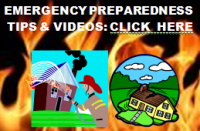By Fire Chief Sam DiGiovanna
May 2, 2025 (San Diego’s East County) -- April and May mark the beginning of rattlesnake season which continues through the summer months. At one point or another, while hiking, golfing or depending upon where you live, you’ve probably encountered them at least one time. Unless you’re one of those odd people who seem to like getting startled by a rattler, encountering snakes is not a pleasant experience for most. But it doesn’t have to be a dangerous one.
With temperatures heating up, there have been reports that rattlesnake sightings are on the increase. Snakes come out of their hiding places and are looking for food. So there’s plenty of reasons to be proactive and remind ourselves and others the commonsense of snake safety.
Practice these precautions:
- Be on the lookout when walking the hillsides, especially if you’re operating loud machinery that may make it difficult to hear the signature rattle. Note: If you’re wearing headphones, keep music low and practice additional caution.
- Make your home less hospitable to snakes. Yard debris, wood piles, gaps under homes, wooden decks, cement patios and open water sources (snakes feel the drought too!) can attract snakes. Remove brush piles and fill gaps as much as possible. Watch for snakes around pools and ponds.
- Keep bushes and shrubs six inches or less off the ground. According to Jim Cornett, a desert ecologist and author of the book Desert Snakes, this will make the snake feel less secure when hiding, so it will be more likely to move along on its way.
- Watch your feet and hands. If you lose sight of them, such as when you reach under a rock or step into a brush pile, the potential to be bitten increases.
- If you encounter a snake, don’t antagonize it. Giving them space is the best approach. They will generally slither along on their own accord!
- If you are bitten by a rattlesnake, stay calm, dial 911 and seek immediate help. Lie down and keep the affected limb lower than the heart.
Note: The information in this article was compiled from various sources. These suggestions are not a complete list of every preventative or loss control measure. The information is not intended to replace additional safety manuals or the advice of another qualified professional(s). We make no guarantee of results from use of this information. We assume no liability in connection with the information nor the suggestions made.










Comments
When walking in an area that rattlesnakes might like,
Also...